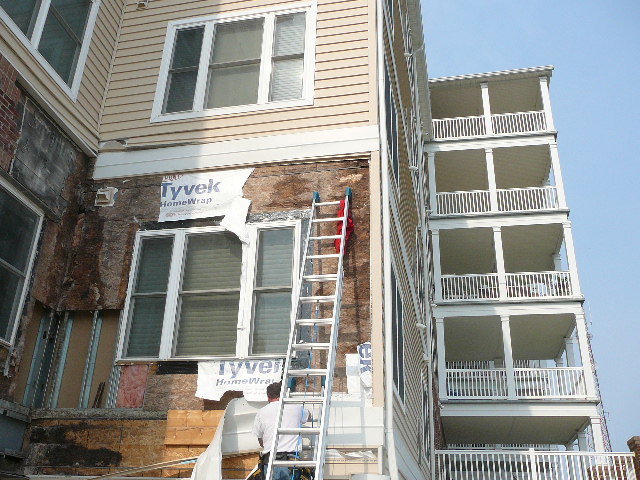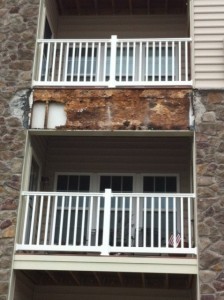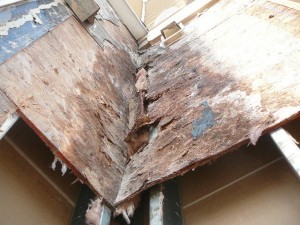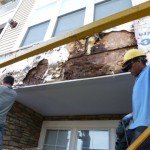 Latent Defects: many of the construction defects that we investigate for condominiums and HOAs are latent in nature, meaning the defects are concealed from view because they are located within exterior wall assemblies or otherwise hidden behind exterior building veneer systems, such as vinyl siding, brick masonry, architectural stone wall systems, EFIS (Exterior Insulation Finishing System), etc.
Latent Defects: many of the construction defects that we investigate for condominiums and HOAs are latent in nature, meaning the defects are concealed from view because they are located within exterior wall assemblies or otherwise hidden behind exterior building veneer systems, such as vinyl siding, brick masonry, architectural stone wall systems, EFIS (Exterior Insulation Finishing System), etc.
Maryland Construction Defect Attorneys
Latent defects can occur during the construction of new condominiums as well as in the renovation of older buildings into condominiums (“condominium conversions”). These defects are covered by applicable warranties, but timely action must be taken to preserve warranty rights.
Construction defects found in Maryland condominiums and HOA communities (as well as in apartments, hotels, commercial buildings, warehouses and office buildings) that we represent often involve improper sequencing or application of construction materials and building products which are difficult to identify or recognize without training, knowledge or experience in building science, materials application and construction practices. These types of construction defects, including failure to follow county approved plans and specifications, building code violation and deviation from construction industry standards, can remain undetected by unit owners, condominium associations and property owners because they may not result in any observable damage for years. Additionally, defects in the construction of a building that may be obvious or suspect to an architect, engineer or other construction profession, may appear to be of no significance to the untrained eye.
Unit owner discovery of defects in newly constructed condominiums is made more difficult because the developer typically retains control over the governance of the condominium association during its early years. As such, the developer controls maintenance and repair of all common elements, including exterior walls and roofs. Thus, until the homeowners take control of the maintenance and repair of the common elements, they may not become aware of a need for an investigation of building construction issues.
The roofs and exterior wall systems and building components of a new building need sufficient exposure to time and the elements to determine if they are properly constructed and installed and capable of separating or selectively filtering the external environment from the interior environment in their geographical location. As a result, it is difficult to determine whether or not a building, such as a condominium, is performing as intended until it has been in service for a number of years. It is for this reason that we have warranty periods and time periods within which claims for repair of construction defects can be made. See blog post: Construction Defect Warranty Claims.
Every construction defect consultant or expert has a story about how water infiltration through the exterior walls of a building went on for years causing major structural damage within a building structure long before the underlying building defect causing the water infiltration finally manifested itself in the form of identifiable leaks within the interior living space of the building. In some cases, these insidious latent defects evade discovery for prolonged periods because water entry into the building is limited but the accumulative effect results in a structural failure over time, or because many building materials can withstand direct exposure to moisture/water for periods of time before they begin to display evidence of being compromised.
It is for these reasons that we recommend that condominiums and new building owners obtain a construction evaluation report before warranties and other legal rights expire and while builders and developers still have an obligation to repair. In the HOA and Condominium industry such a report are typically referred to a “transition study,” (also known as a “warranty analysis,” “deficiency report,” “construction analysis report,” et) Generally, these reports are deigned to identify defects or areas of concern that should be investigated. They are in essence a preventative healthcare check up for condominium buildings. They often enable a condominium to identify construction problems and bring them to the developers attention for repair before warranties expire. These reports are typically performed by engineers, architects and construction consultants. It is very important to select the right professional and have a report tailored to the community art issue.
In order to make informed decisions, a board of directors must understand rights of the community in the transition process including when warranties and other legal rights for construction defects expire and how to preserve and protect those rights so they do not get waived in the process. There is no one answer for every condominium. Each case is different and advice should be tailored to each community.
When defects are discovered, identified and brought to the attention of the developer early in the transition process under applicable warranties, the chances of resolving the construction defect disputes without litigation greatly increase. Extensive damage is less likely to have occurred, repairs are less expensive and easier to perform, the developer may still have a relationship with the viable subcontractors that can be called back to address problems, the developer may still be selling units, and warranties and other legal rights are still enforceable.
Negotiations, however, should always be conducted with the involvement of a construction consultant to ensure all developer proposed repairs will be appropriate and effective. Additionally, an attorney with extensive experience handling condominium construction defect disputes and claims involving warranties is essential to make sure that the rights of the condominium association rights are preserved and that it obtains the best deal possible for the community. Construction defect law as it applies to the rights of community associations and their members is an extremely complex area of law with many pit falls to be avoided. I have seen some terrible outcomes for communities who did not follow this advise.
Condominiums associations who have just transitioned from developer control or who are experiencing construction problems can consult with an experienced condominium construction defect attorney without fee or obligation. Cowie Law Group will review a community association’s documents and meet with the board of directors at the condominium to explain how warranties and other legal rights apply, when they expire, and how to preserve them. Additionally, based on our years of experience we will map out a clear an concise strategy for identifying and resolving construction defect disputes and obtaining proper repairs from your developer with accountability and potetial expense reimbursement. In fact, it is highly likely that we have already negotiated numerous construction defect disputes with your developer over the past 30 years. After our fee consultation, your community will have the information necessary to be on equal footing with the developer and to make informed decisions as to how to best proceed to protect the rights of the association.
Below is a reprint of an Article regarding the importance of obtaining a transition study that was published by the Community Associations Institute, Chesapeake Region and Washington Metro Chapter Publications (The Beacon and The Quorum):
CONSTRUCTION DEFECT JURY VERDICT DEMONSTRATES
IMPORTANCE OF TIMELY TRANSITION STUDY
A recent construction defect case demonstrates the importance of performing a “transition study” as soon as governance of a condominium association is transferred from developer to unit owner control.
Why and When to Conduct a Transition Study
One of the most important challenges facing the first unit owner controlled board of directors is to determine whether the developer-created budget and reserve fund are adequate to cover the cost of maintaining the condominium’s construction over time. It is important to note that budgets and reserves are calculated based on the assumptions that the condominium facilities are constructed properly and have a normal life expectancy (e.g., a 25 or 30 year roof). Making such an assumption can be costly. Construction defects in the original construction can cause unanticipated repair and replacement expenses that wreak havoc on an association’s financial condition and long-term stability.
Construction defects may not be apparent when unit owners take control of the association. Defects can remain hidden for years until they manifested in the form of property damage (for example, water staining and leaks at roofs or windows). Left undiscovered and unrepaired, even minor, “easy to fix” construction deficiencies can result in extensive, hidden property damage requiring associations to borrow money and assess unit owners to cover the entire cost of repairing the developer’s construction defects and resulting property damages.
For these reasons, upon assuming control from a developer, the unit owner-controlled board should not assume that construction is proper. Rather, it should be a priority to hire an engineer or architect to perform a transition study (also referred to as a “deficiency report” or “warranty analysis”) to evaluate building construction and identify potential construction defects while warranties are still enforceable so that any construction defects revealed can be submitted to the developer for warranty repairs at the developer’s expense.
A Case Study: Defects Timely Revealed Enable Association to Make Multi Million Dollar Warranty Claim
The importance of a timely transition study is illustrated by a recent court case involving the Eden Brook Condominium, a 224-unit, 55-and-over, residential community in Odenton, Maryland. A transition study performed by an engineering company soon after the developer turned over control of the association to the unit owners revealed violations of building codes and industry standards in the construction of the exterior brick walls and installation of windows. The association’s consultants determined that extensive and costly repairs were required to repair these defects that would continue to cause damage to the buildings if not corrected.
The association, with the assistance of its legal counsel, was able to use the transition study to bring the defects to the attention of the developer, Ryan Homes, and preserve the association’s warranty claims before they expired. Ultimately, attempts to have the developer correct the defects failed and the association was forced to sue for the cost of repairing the defects. On November 19, 2012, following a five-week trial in the Anne Arundel County Circuit Court, a jury awarded the association $5,629,715 for the cost of repairing the defects.
Lessons Learned
Without a timely transition study the association may not have discovered the defects until it was too late to preserve its legal rights, a result that would have saddled the unit owners with assessments for the total cost of repair and may have exposed the association to legal liability from its own membership.
Many condominium associations do not hire an engineer or architect to evaluate the construction of the condominium until they begin experiencing problems years after control of the association passes from the developer to the unit owners. This is a big mistake. Our law firm is regularly contacted by associations whose claims are either compromised or barred by statute of limitations because they never performed a transition study that would likely have revealed the construction defects.
An amicable repair resolution is more likely when a transition study is presented to the developer while warranties are still enforceable. To ensure that developer repairs are proper and warranties are preserved it is essential that a newly formed unit owner-controlled association involve a qualified construction consultant and experienced construction defect attorney. An association that preserves its warranty claims in this manner will be able to legally enforce them should it become necessary.
Nicholas D. Cowie is a member of COWIE LAW GROUP, P.C. the law firm that represented Eden Brook Condominium Association in the litigation referenced in this article. Partners, George Bealefeld and Stanford Kimmel, served a trial counsel in that case.

Maryland & DC Condominium Construction Defect Lawyers
410-327-3800 I 301-830-8315 I 202-670-6289
